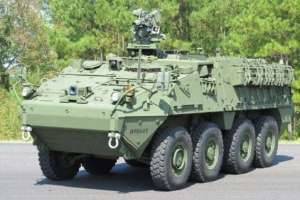Articles >>
Stryker `Double V-Hull` Proven Success
Category: Army

More than 18 months ago, the Army`s Stryker combat vehicle underwent a game-changing transformation when the service took lessons learned from theater and incorporated an improved hull design to protect Soldiers from improvised explosive devices and roadside mines. The new underbody design, known as a "double v-hull", or DVH, was based on proven technology similar to that found on mine resistant ambush protected vehicles which deflect blasts away from the vehicle and the Soldiers inside. The Stryker DVH took the concept a step further by incorporating enhanced armor, a new suspension and blast-attenuating seats. This rapid engineering effort went from conception to production in less than one year and debuted in Afghanistan in early summer 2011. As of this month, 673 Stryker DVHs have been produced, of which more than 450 have been fielded to Afghanistan. With more than a year and a half of combat experience now, there is enough data to declare the Stryker DVH a success, said Lt. Col. Eric Frutchey, product manager for the Stryker fleet. "While deployed to Operation Enduring Freedom, the Stryker DVH has seen enemy fire and come through with outstanding survivability results," Frutchey said. "The majority of Soldiers involved in those instances have walked away from the vehicles, or returned to duty within a short period of time. Not only have the number of injuries and casualties dropped dramatically, but the severity of those instances has substantially decreased." While better protecting Soldiers is the most important development of the DVH effort, the improved operational readiness rates are also an important advancement. Frutchey said the Stryker DVH's operational readiness rate has "measurably improved" to an average monthly rate of 99 percent. That, he said, is largely due to the upgraded carrying capacity and the robustness of the new 55,000-pound capacity suspension. The Stryker's operational readiness rate means that 99 percent of the time, it is "ready to roll" when called upon by Soldiers in the field. This means not only has the DVH cut down on Soldier injuries, but that it has done so while being ready for more combat missions. The Army is looking to further enhance Soldier safety in Stryker DVHs by applying an integrated mine roller system to the front of select Stryker DVHs. By initiating the explosion away from the vehicles they are attached to, Soldiers within Stryker DVH can gain even greater protection. Currently, 144 mine rollers and 80 kits for integration onto Strykers have been delivered in Afghanistan, and more are on the way. As the Army continues to discuss the proper fleet mix of DVH and traditional flat-bottom Strykers, the project manager of the Stryker Brigade Combat Team has begun a pilot exchange program, in partnership with Anniston Army Depot and General Dynamics Land Systems, in response to the Army's request for additional DVH vehicles at a reduced vehicle cost. "To maximize the use of fiscal resources, the Army started the exchange program to validate if components from the traditional Stryker flat bottom hull variants could be expeditiously refurbished and installed on a new, more survivable DVH, at less cost than producing a new vehicle," said David Dopp, PM SBCT. The process includes reusing common parts from FBHs, refurbishing them, and re-using the parts in the new DVH structure. The DVH exchange vehicles are expected to have all of the same capabilities as new DVH production vehicles. The DVH exchange vehicles are built on the same production line as new DVH vehicles. The exchange program is scheduled to be complete in early 2013. While further vehicles will have to be completed for the Army to know exact savings, it is currently estimated that DVH exchange vehicles will cost 40 percent less, when comparing them to a newly constructed DVH version. The first DVH exchange vehicle is scheduled to be fielded to the force in December. |
US Army |
General Dynamics Land SystemsľUK showcases adaptable Foxhound vehicle at DSEI 2019
23.09.2019
General Dynamics Receives Contract to Upgrade U.S. Army Strykers to A1 Configuration
28.06.2018
General Dynamics Land SystemsľUK Showcases EAGLE Platform Ahead of MRV-P Programme Trials
14.09.2017
General Dynamics Land SystemsľUK showcases PIRANHA 5 at DSEI
14.09.2017
STRYKER ICV (Wheeled armoured personnel carrier)
STRYKER M1129 MC (Mortar vehicle)
Stryker ICV (Wheeled armoured personnel carrier)
STRYKER (Self-propelled howitzer)
STRYKER IFV M1126 (Infantry fighting vehicle)
STRYKER M1127 RV (Wheeled armoured personnel carrier)
STRYKER M1130 CV (Command vehicle)
STRYKER M1132 ECV (Engineer vehicle)
STRYKER M1133 (Ambulance vehicle)
STRYKER M1134 (Self-propelled antitank guided missile system)
STRYKER M1135 NBCRV (Nuclear/biological/chemical reconnaissance vehicle)
STRYKER M1132 (Mine clearing vehicle)
STRYKER XM1128 MGS (Fire support vehicle)
STRYKER XM1134 (Self-propelled antitank guided missile system)
STRYKER M1131 FSV (Fire support vehicle)
STRYKER M1133 MEV (Ambulance vehicle)
Ň╠1296 Stryker ICV Dragoon (Modernization of the vehicle)
Discuss
